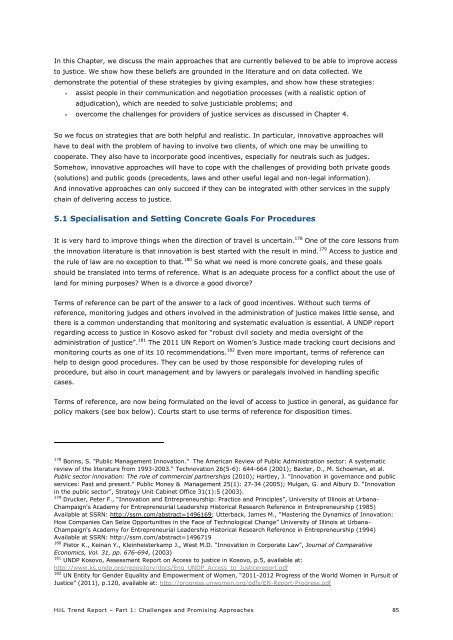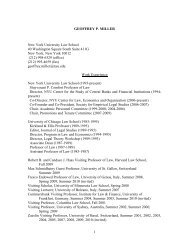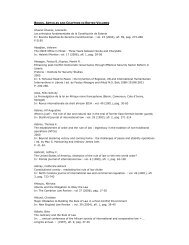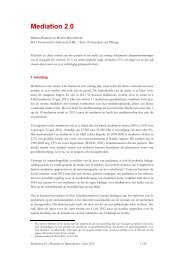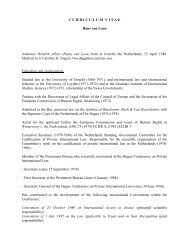Trend Report | Part 1 - HiiL
Trend Report | Part 1 - HiiL
Trend Report | Part 1 - HiiL
Create successful ePaper yourself
Turn your PDF publications into a flip-book with our unique Google optimized e-Paper software.
In this Chapter, we discuss the main approaches that are currently believed to be able to improve access<br />
to justice. We show how these beliefs are grounded in the literature and on data collected. We<br />
demonstrate the potential of these strategies by giving examples, and show how these strategies:<br />
assist people in their communication and negotiation processes (with a realistic option of<br />
adjudication), which are needed to solve justiciable problems; and<br />
overcome the challenges for providers of justice services as discussed in Chapter 4.<br />
So we focus on strategies that are both helpful and realistic. In particular, innovative approaches will<br />
have to deal with the problem of having to involve two clients, of which one may be unwilling to<br />
cooperate. They also have to incorporate good incentives, especially for neutrals such as judges.<br />
Somehow, innovative approaches will have to cope with the challenges of providing both private goods<br />
(solutions) and public goods (precedents, laws and other useful legal and non-legal information).<br />
And innovative approaches can only succeed if they can be integrated with other services in the supply<br />
chain of delivering access to justice.<br />
5.1 Specialisation and Setting Concrete Goals For Procedures<br />
It is very hard to improve things when the direction of travel is uncertain. 178 One of the core lessons from<br />
the innovation literature is that innovation is best started with the result in mind. 179 Access to justice and<br />
the rule of law are no exception to that. 180 So what we need is more concrete goals, and these goals<br />
should be translated into terms of reference. What is an adequate process for a conflict about the use of<br />
land for mining purposes? When is a divorce a good divorce?<br />
Terms of reference can be part of the answer to a lack of good incentives. Without such terms of<br />
reference, monitoring judges and others involved in the administration of justice makes little sense, and<br />
there is a common understanding that monitoring and systematic evaluation is essential. A UNDP report<br />
regarding access to justice in Kosovo asked for “robust civil society and media oversight of the<br />
administration of justice”. 181 The 2011 UN <strong>Report</strong> on Women’s Justice made tracking court decisions and<br />
monitoring courts as one of its 10 recommendations. 182 Even more important, terms of reference can<br />
help to design good procedures. They can be used by those responsible for developing rules of<br />
procedure, but also in court management and by lawyers or paralegals involved in handling specific<br />
cases.<br />
Terms of reference, are now being formulated on the level of access to justice in general, as guidance for<br />
policy makers (see box below). Courts start to use terms of reference for disposition times.<br />
178 Borins, S. "Public Management Innovation." The American Review of Public Administration sector: A systematic<br />
review of the literature from 1993-2003." Technovation 26(5-6): 644-664 (2001); Baxter, D., M. Schoeman, et al.<br />
Public sector innovation: The role of commercial partnerships (2010); Hartley, J. "Innovation in governance and public<br />
services: Past and present." Public Money & Management 25(1): 27-34 (2005); Mulgan, G. and Albury D. “Innovation<br />
in the public sector”, Strategy Unit Cabinet Office 31(1):5 (2003).<br />
179 Drucker, Peter F., “Innovation and Entrepreneurship: Practice and Principles”, University of Illinois at Urbana-<br />
Champaign's Academy for Entrepreneurial Leadership Historical Research Reference in Entrepreneurship (1985)<br />
Available at SSRN: http://ssrn.com/abstract=1496169; Utterback, James M., “Mastering the Dynamics of Innovation:<br />
How Companies Can Seize Opportunities in the Face of Technological Change” University of Illinois at Urbana-<br />
Champaign's Academy for Entrepreneurial Leadership Historical Research Reference in Entrepreneurship (1994)<br />
Available at SSRN: http://ssrn.com/abstract=1496719<br />
180 Pistor K., Keinan Y., Kleinheisterkamp J., West M.D. “Innovation in Corporate Law”, Journal of Comparative<br />
Economics, Vol. 31, pp. 676-694, (2003)<br />
181 UNDP Kosovo, Assessment <strong>Report</strong> on Access to justice in Kosovo, p.5, available at:<br />
http://www.ks.undp.org/repository/docs/Eng_UNDP_Access_to_Justicereport.pdf<br />
182 UN Entity for Gender Equality and Empowerment of Women, “2011-2012 Progress of the World Women in Pursuit of<br />
Justice” (2011), p.120, available at: http://progress.unwomen.org/pdfs/EN-<strong>Report</strong>-Progress.pdf<br />
<strong>HiiL</strong> <strong>Trend</strong> <strong>Report</strong> – <strong>Part</strong> 1: Challenges and Promising Approaches 85


